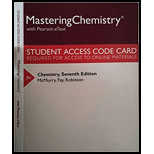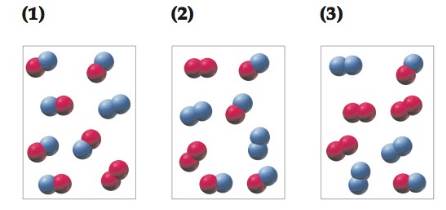
Chemistry - Modified MasteringChemistry
7th Edition
ISBN: 9780133892321
Author: McMurry
Publisher: PEARSON
expand_more
expand_more
format_list_bulleted
Textbook Question
Chapter 14, Problem 14.16A
Conceptual APPLY 14.16 The reaction A2 + B2

(a) Which reaction mixture is at equilibrium?
(b) For those reaction mixtures that are not at equilibrium, will the net reaction go in the forward or reverse direction to reachequilibrium?
Expert Solution & Answer
Trending nowThis is a popular solution!

Students have asked these similar questions
please help me with my homework
help
The temperature on a sample of pure X held at 1.25 atm and -54. °C is increased until the sample boils. The temperature is then held constant and the
pressure is decreased by 0.42 atm. On the phase diagram below draw a path that shows this set of changes.
pressure (atm)
2
0
0
200
400
temperature (K)
X
Chapter 14 Solutions
Chemistry - Modified MasteringChemistry
Ch. 14 - Prob. 14.1PCh. 14 - APPLY 14.2 Nitrogen dioxide, a pollutant that...Ch. 14 - Prob. 14.3PCh. 14 - APPLY 14.4 Lactic acid, which builds up in muscle...Ch. 14 - Conceptual PRACTICE 14.5 The following pictures...Ch. 14 - Conceptual APPLY 14.6 The equilibrium constant...Ch. 14 - PRACTICE 14.7 In the industrial synthesis of...Ch. 14 - APPLY 14.8 At 25 °C, Kp = 25 for the reaction...Ch. 14 - Prob. 14.9PCh. 14 - APPLY 14.10For the reaction...
Ch. 14 - Prob. 14.11PCh. 14 - APPLY 14.12 Magnesium hydroxide is the active...Ch. 14 - Prob. 14.13PCh. 14 - Prob. 14.14ACh. 14 - Prob. 14.15PCh. 14 - Conceptual APPLY 14.16 The reaction A2 + B2 2...Ch. 14 - PRACTICE 14.17 The H2/CO ratio in mixtures of...Ch. 14 - APPLY 14.18 Calculate the equilibrium...Ch. 14 - PRACTICE 14.19 Calculate the equilibrium...Ch. 14 - APPLY 14.20 Calculate the equilibrium...Ch. 14 - Prob. 14.21PCh. 14 - Prob. 14.22ACh. 14 - Prob. 14.23PCh. 14 - Prob. 14.24ACh. 14 - Prob. 14.25PCh. 14 - Prob. 14.26ACh. 14 - Prob. 14.27PCh. 14 - Prob. 14.28ACh. 14 - Prob. 14.29PCh. 14 - Prob. 14.30ACh. 14 - Prob. 14.31PCh. 14 - Prob. 14.32ACh. 14 - Prob. 14.33PCh. 14 - Prob. 14.34PCh. 14 - Prob. 14.35PCh. 14 - Prob. 14.36PCh. 14 - PROBLEM 14.37 The affinity of hemoglobin (Hb) for...Ch. 14 - Prob. 14.38PCh. 14 - Prob. 14.39CPCh. 14 - The following pictures represent the equilibrium...Ch. 14 - The reaction A2+BA+AB has an equilibrium constant...Ch. 14 - Prob. 14.42CPCh. 14 - Prob. 14.43CPCh. 14 - Prob. 14.44CPCh. 14 - The following pictures represent equilibrium...Ch. 14 - Prob. 14.46CPCh. 14 - Prob. 14.47CPCh. 14 - Prob. 14.48CPCh. 14 - Prob. 14.49CPCh. 14 - Prob. 14.50SPCh. 14 - Identify the true statement about the...Ch. 14 - Prob. 14.52SPCh. 14 - Prob. 14.53SPCh. 14 - For each of the following equilibria, write the...Ch. 14 - Prob. 14.55SPCh. 14 - Prob. 14.56SPCh. 14 - Prob. 14.57SPCh. 14 - For each of the following equilibria, write the...Ch. 14 - Prob. 14.59SPCh. 14 - 14.60 If Kc = 7.5 × 10-9 at 1000 K for the...Ch. 14 - Prob. 14.61SPCh. 14 - Prob. 14.62SPCh. 14 - Prob. 14.63SPCh. 14 - Prob. 14.64SPCh. 14 - Prob. 14.65SPCh. 14 - Prob. 14.66SPCh. 14 - Prob. 14.67SPCh. 14 - Prob. 14.68SPCh. 14 - Prob. 14.69SPCh. 14 - Prob. 14.70SPCh. 14 - Prob. 14.71SPCh. 14 - Prob. 14.72SPCh. 14 - Prob. 14.73SPCh. 14 - Prob. 14.74SPCh. 14 - Prob. 14.75SPCh. 14 - Prob. 14.76SPCh. 14 - Prob. 14.77SPCh. 14 - Prob. 14.78SPCh. 14 - Prob. 14.79SPCh. 14 - Prob. 14.80SPCh. 14 - Prob. 14.81SPCh. 14 - Prob. 14.82SPCh. 14 - Prob. 14.83SPCh. 14 - Prob. 14.84SPCh. 14 - Prob. 14.85SPCh. 14 - Prob. 14.86SPCh. 14 - Prob. 14.87SPCh. 14 - Prob. 14.88SPCh. 14 - Prob. 14.89SPCh. 14 - Prob. 14.90SPCh. 14 - Prob. 14.91SPCh. 14 - Prob. 14.92SPCh. 14 - Prob. 14.93SPCh. 14 - Prob. 14.94SPCh. 14 - Prob. 14.95SPCh. 14 - Prob. 14.96SPCh. 14 - Prob. 14.97SPCh. 14 - Prob. 14.98SPCh. 14 - Prob. 14.99SPCh. 14 - Prob. 14.100SPCh. 14 - Prob. 14.101SPCh. 14 - Prob. 14.102SPCh. 14 - Prob. 14.103SPCh. 14 - Prob. 14.104SPCh. 14 - Consider the endothermic reaction...Ch. 14 - Prob. 14.106SPCh. 14 - Prob. 14.107SPCh. 14 - Prob. 14.108SPCh. 14 - Prob. 14.109SPCh. 14 - Prob. 14.110SPCh. 14 - Prob. 14.111SPCh. 14 - Prob. 14.112SPCh. 14 - Prob. 14.113SPCh. 14 - Prob. 14.114SPCh. 14 - Prob. 14.115SPCh. 14 - Prob. 14.116SPCh. 14 - Prob. 14.117SPCh. 14 - Prob. 14.118SPCh. 14 - Forward and reverse rate constants for the...Ch. 14 - Prob. 14.120CPCh. 14 - Prob. 14.121CPCh. 14 - Prob. 14.122CPCh. 14 - Prob. 14.123CPCh. 14 - Prob. 14.124CPCh. 14 - Prob. 14.125CPCh. 14 - Prob. 14.126CPCh. 14 - Prob. 14.127CPCh. 14 - Prob. 14.128CPCh. 14 - Prob. 14.129CPCh. 14 - Prob. 14.130CPCh. 14 - At 1000 K, Kp, = 2.1 106 and H=107.7kJ for the...Ch. 14 - Prob. 14.132CPCh. 14 - Prob. 14.133CPCh. 14 - Prob. 14.134CPCh. 14 - Prob. 14.135CPCh. 14 - Prob. 14.136CPCh. 14 - Prob. 14.137CPCh. 14 - Prob. 14.138CPCh. 14 - Prob. 14.139CPCh. 14 - Prob. 14.140CPCh. 14 - Prob. 14.141CPCh. 14 - Prob. 14.142CPCh. 14 - Prob. 14.143CPCh. 14 - Prob. 14.144CPCh. 14 - Prob. 14.145CPCh. 14 - Prob. 14.146CPCh. 14 - Prob. 14.147MPCh. 14 - Prob. 14.148MPCh. 14 - Prob. 14.149MPCh. 14 - Prob. 14.150MPCh. 14 - Prob. 14.151MPCh. 14 - Prob. 14.152MPCh. 14 - Prob. 14.153MPCh. 14 - Prob. 14.154MPCh. 14 - Prob. 14.155MPCh. 14 - Prob. 14.156MPCh. 14 - Prob. 14.157MPCh. 14 - Prob. 14.158MPCh. 14 - Prob. 14.159MP
Knowledge Booster
Learn more about
Need a deep-dive on the concept behind this application? Look no further. Learn more about this topic, chemistry and related others by exploring similar questions and additional content below.Similar questions
- QUESTION: Answer Question 5: 'Calculating standard error of regression' STEP 1 by filling in all the empty green boxes *The values are all provided in the photo attached*arrow_forwardpressure (atm) 3 The pressure on a sample of pure X held at 47. °C and 0.88 atm is increased until the sample condenses. The pressure is then held constant and the temperature is decreased by 82. °C. On the phase diagram below draw a path that shows this set of changes. 0 0 200 temperature (K) 400 аarrow_forwarder your payment details | bar xb Home | bartleby x + aleksogi/x/isl.exe/1o u-lgNskr7j8P3jH-1Qs_pBanHhviTCeeBZbufuBYT0Hz7m7D3ZcW81NC1d8Kzb4srFik1OUFhKMUXzhGpw7k1 O States of Matter Sketching a described thermodynamic change on a phase diagram 0/5 The pressure on a sample of pure X held at 47. °C and 0.88 atm is increased until the sample condenses. The pressure is then held constant and the temperature is decreased by 82. °C. On the phase diagram below draw a path that shows this set of changes. pressure (atm) 1 3- 0- 0 200 Explanation Check temperature (K) 400 X Q Search L G 2025 McGraw Hill LLC. All Rights Reserved Terms of Use Privacy Cearrow_forward
- 5.arrow_forward6.arrow_forward0/5 alekscgi/x/sl.exe/1o_u-IgNglkr7j8P3jH-IQs_pBaHhvlTCeeBZbufuBYTi0Hz7m7D3ZcSLEFovsXaorzoFtUs | AbtAURtkqzol 1HRAS286, O States of Matter Sketching a described thermodynamic change on a phase diagram The pressure on a sample of pure X held at 47. °C and 0.88 atm is increased until the sample condenses. The pressure is then held constant and the temperature is decreased by 82. °C. On the phase diagram below draw a path that shows this set of changes. 3 pressure (atm) + 0- 0 5+ 200 temperature (K) 400 Explanation Check X 0+ F3 F4 F5 F6 F7 S 2025 McGraw Hill LLC All Rights Reserved. Terms of Use Privacy Center Accessibility Q Search LUCR + F8 F9 F10 F11 F12 * % & ( 5 6 7 8 9 Y'S Dele Insert PrtSc + Backsarrow_forward
- 5.arrow_forward9arrow_forwardalekscgi/x/lsl.exe/1o_u-IgNslkr7j8P3jH-IQs_pBanHhvlTCeeBZbufu BYTI0Hz7m7D3ZS18w-nDB10538ZsAtmorZoFusYj2Xu9b78gZo- O States of Matter Sketching a described thermodynamic change on a phase diagram 0/5 The pressure on a sample of pure X held at 47. °C and 0.88 atm is increased until the sample condenses. The pressure is then held constant and the temperature is decreased by 82. °C. On the phase diagram below draw a path that shows this set of changes. pressure (atm) 3- 200 temperature (K) Explanation Chick Q Sowncharrow_forward
- 0+ aleksog/x/lsl.exe/1ou-lgNgkr7j8P3H-IQs pBaHhviTCeeBZbufuBYTOHz7m7D3ZStEPTBSB3u9bsp3Da pl19qomOXLhvWbH9wmXW5zm O States of Matter Sketching a described thermodynamic change on a phase diagram 0/5 Gab The temperature on a sample of pure X held at 0.75 atm and -229. °C is increased until the sample sublimes. The temperature is then held constant and the pressure is decreased by 0.50 atm. On the phase diagram below draw a path that shows this set of changes. F3 pressure (atm) 0- 0 200 Explanation temperature (K) Check F4 F5 ☀+ Q Search Chill Will an 9 ENG F6 F7 F8 F9 8 Delete F10 F11 F12 Insert PrtSc 114 d Ararrow_forwardx + LEKS: Using a phase diagram a X n/alekscgi/x/lsl.exe/10_u-IgNsikr7j8P3jH-IQs_pBan HhvlTCeeBZbufu BYTI0Hz7m7D3ZcHYUt80XL-5alyVpw ○ States of Matter Using a phase diagram to find a phase transition temperature or pressure Use the phase diagram of Substance X below to find the melting point of X when the pressure above the solid is 1.1 atm. pressure (atm) 16 08- solid liquid- 0 200 400 gas 600 temperature (K) Note: your answer must be within 25 °C of the exact answer to be graded correct. × 5arrow_forwardS: Using a phase diagram leksogi/x/sl.exe/1ou-IgNs kr 7j8P3jH-IQs_pBan HhvTCeeBZbufuBYTI0Hz7m7D3ZdHYU+80XL-5alyVp O States of Matter Using a phase diagram to find a phase transition temperature or pressure se the phase diagram of Substance X below to find the boiling point of X when the pressure on the liquid is 1.6 atm. pressure (atm) 32- 16- solid liquid 0. gas 100 200 temperature (K) 300 Note: your answer must be within 12.5 °C of the exact answer to be graded correct. 10 Explanation Check § Q Search J 2025 McGraw Hill LLC. All Rights Researrow_forward
arrow_back_ios
SEE MORE QUESTIONS
arrow_forward_ios
Recommended textbooks for you
 General Chemistry - Standalone book (MindTap Cour...ChemistryISBN:9781305580343Author:Steven D. Gammon, Ebbing, Darrell Ebbing, Steven D., Darrell; Gammon, Darrell Ebbing; Steven D. Gammon, Darrell D.; Gammon, Ebbing; Steven D. Gammon; DarrellPublisher:Cengage Learning
General Chemistry - Standalone book (MindTap Cour...ChemistryISBN:9781305580343Author:Steven D. Gammon, Ebbing, Darrell Ebbing, Steven D., Darrell; Gammon, Darrell Ebbing; Steven D. Gammon, Darrell D.; Gammon, Ebbing; Steven D. Gammon; DarrellPublisher:Cengage Learning Chemistry: The Molecular ScienceChemistryISBN:9781285199047Author:John W. Moore, Conrad L. StanitskiPublisher:Cengage Learning
Chemistry: The Molecular ScienceChemistryISBN:9781285199047Author:John W. Moore, Conrad L. StanitskiPublisher:Cengage Learning Chemistry: Principles and PracticeChemistryISBN:9780534420123Author:Daniel L. Reger, Scott R. Goode, David W. Ball, Edward MercerPublisher:Cengage Learning
Chemistry: Principles and PracticeChemistryISBN:9780534420123Author:Daniel L. Reger, Scott R. Goode, David W. Ball, Edward MercerPublisher:Cengage Learning Chemistry & Chemical ReactivityChemistryISBN:9781337399074Author:John C. Kotz, Paul M. Treichel, John Townsend, David TreichelPublisher:Cengage Learning
Chemistry & Chemical ReactivityChemistryISBN:9781337399074Author:John C. Kotz, Paul M. Treichel, John Townsend, David TreichelPublisher:Cengage Learning Chemistry & Chemical ReactivityChemistryISBN:9781133949640Author:John C. Kotz, Paul M. Treichel, John Townsend, David TreichelPublisher:Cengage Learning
Chemistry & Chemical ReactivityChemistryISBN:9781133949640Author:John C. Kotz, Paul M. Treichel, John Townsend, David TreichelPublisher:Cengage Learning ChemistryChemistryISBN:9781305957404Author:Steven S. Zumdahl, Susan A. Zumdahl, Donald J. DeCostePublisher:Cengage Learning
ChemistryChemistryISBN:9781305957404Author:Steven S. Zumdahl, Susan A. Zumdahl, Donald J. DeCostePublisher:Cengage Learning

General Chemistry - Standalone book (MindTap Cour...
Chemistry
ISBN:9781305580343
Author:Steven D. Gammon, Ebbing, Darrell Ebbing, Steven D., Darrell; Gammon, Darrell Ebbing; Steven D. Gammon, Darrell D.; Gammon, Ebbing; Steven D. Gammon; Darrell
Publisher:Cengage Learning

Chemistry: The Molecular Science
Chemistry
ISBN:9781285199047
Author:John W. Moore, Conrad L. Stanitski
Publisher:Cengage Learning

Chemistry: Principles and Practice
Chemistry
ISBN:9780534420123
Author:Daniel L. Reger, Scott R. Goode, David W. Ball, Edward Mercer
Publisher:Cengage Learning

Chemistry & Chemical Reactivity
Chemistry
ISBN:9781337399074
Author:John C. Kotz, Paul M. Treichel, John Townsend, David Treichel
Publisher:Cengage Learning

Chemistry & Chemical Reactivity
Chemistry
ISBN:9781133949640
Author:John C. Kotz, Paul M. Treichel, John Townsend, David Treichel
Publisher:Cengage Learning

Chemistry
Chemistry
ISBN:9781305957404
Author:Steven S. Zumdahl, Susan A. Zumdahl, Donald J. DeCoste
Publisher:Cengage Learning
Chemical Equilibria and Reaction Quotients; Author: Professor Dave Explains;https://www.youtube.com/watch?v=1GiZzCzmO5Q;License: Standard YouTube License, CC-BY